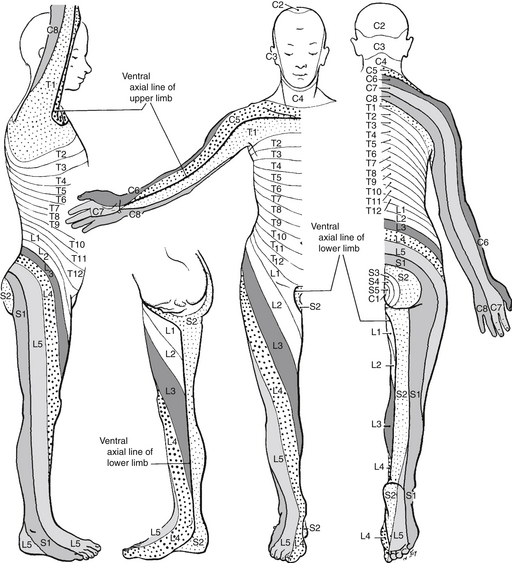Chapter 101
Spinal Injury 
The intensivist managing the patient with major trauma in the intensive care unit (ICU) setting must be vigilant for the presence of a coexistent injury to neural or osteoligamentous components of the spine. The history and neurologic examination determine the functional status and level of the neurologic injury, whereas imaging studies determine the integrity and stability of the osteoligamentous complex. Despite the advances of imaging investigations, plain films remain of value for defining instability, especially in the cervical spine. Computer-assisted imaging (computed tomography [CT]) and magnetic resonance imaging (MRI) are complementary studies, each of which contributes valuable information to the assessment and management of the patient with a spinal injury (Table 101.1).
TABLE 101.1
Imaging Studies for Spinal Injury
| Study | Advantages | Disadvantages |
| Plain radiograph | Performed rapidly as a portable study; can be used to determine stability in flexion and extension | Poor resolution |
| Computed tomography | Shows bony structure well, can be used to reconstruct cervicothoracic junction | Worse than magnetic resonance imaging for tissue densities; not portable |
| Magnetic resonance imaging | Excellent tissue definition (cord, ligament, hematomas) | Poor bone definition, not portable, more time required for study compared with computed tomography |
Pathophysiology and Biomechanics of Spinal Injury
Unstable injuries of the thoracic spine are more likely to occur at the thoracolumbar junction or in the lumbar spine because of the stabilizing capabilities of the rib cage and sternum.
Assessment of Spinal Cord Injury
Sensory Examination
The sensory examination should include assessment of both pain perception and proprioception as these two modalities travel through distinct anatomic tracts in the spinal cord (spinothalamic tracts and posterior columns, respectively). Appreciation of noxious stimulus requires a dermatome-by-dermatome assessment from the highest cervical to the lower sacral levels (Figure 101.1).
The lower cervical and upper thoracic dermatomes (C5-T2) are not represented on the anterior torso. The upper cervical dermatomes (C3-4) extend to the supramammary region, immediately superior to the T3-4 dermatome. Examination of the torso alone results in a sensory assessment that makes the transition from the C4 to the T4 levels, not directly testing the intervening dermatomes. For this reason, a detailed examination must be carried out in the arms and hands to assess these areas. Otherwise, a patient with a low cervical injury can be misdiagnosed as having an upper thoracic injury by a sensory assessment limited to the torso.
The upper extremity sensory assessment must include all six dermatomes represented on the arm for adequate localization of a deficit. Individual leg dermatomes should also be assessed, although disparity in sensory function in a dermatomal pattern after a spinal cord injury is less common in the legs (see Figure 101.1).
The sacral dermatomes, located within the perineal region, should also be tested (see Figure 101.1). The presence of perineal sensation alone (“sacral sparing”) in a patient who otherwise has no demonstrable neurologic function represents an incomplete spinal cord injury, which may have a better prognosis for recovery of spinal cord function than can be expected in a patient with a complete injury.
Reflex Examination
Superficial reflexes are diminished in the presence of a spinal cord injury. Nerves from T6-9 and T10-12 subserve the upper and lower superficial abdominal reflexes, respectively. The absence of both upper and lower superficial abdominal reflexes indicates that the lesion is above T6. The absence of lower and preservation of upper superficial abdominal reflexes indicates that the lesion is below T9. Likewise, the L1-2 segmental nerves mediate the cremasteric reflex, and loss of this reflex is pathologic.

Full access? Get Clinical Tree




